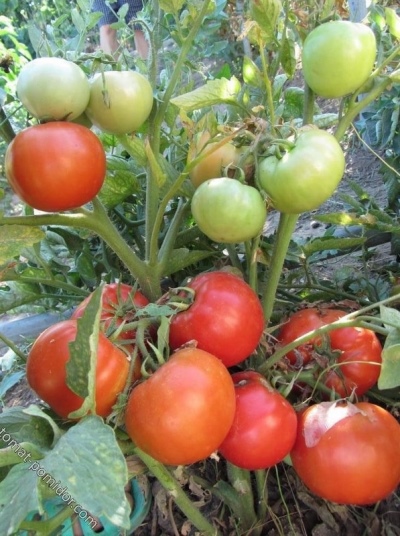
- Category: grade
- Growth type: determinant
- Appointment: fresh consumption
- Ripening period: mid-season
- Growing conditions: for open ground, for film greenhouses
- Bush size: undersized
- Bush height, cm: 60-80
- Ripe fruit color: Red
- Fruit shape: flat-round
- Fruit weight, g: up to 600
Many gardeners, especially those who do not have much experience, try to plant unpretentious and compact varieties of tomatoes on the site. These include the mid-season tomato Stambovy large-fruited, productive, growing both in the garden and in greenhouses.
Description of the variety
Vegetable culture Standard large-fruited is a low-growing plant of the determinant type. The bushes stretch up to 60-80 cm in height in the garden bed, and in the greenhouse - up to 50 cm. The plant is characterized by medium foliage with green leaves, an erect central stem and flexible branches, a developed root system and simple inflorescences. 3-4 fruit clusters are formed on each bush, where 2-4 weighty fruits are tied.
When growing tomatoes, pinching and thinning of the lower leaves are not required. Bushes are formed in 2-3 stems. In addition, the tomatoes are large, so tying to supports may be needed. The purpose of the variety is universal, so tomatoes are eaten fresh, added to various dishes, pickled, processed into a variety of dressings and drinks. Due to their large size, tomatoes are not canned whole.
The main qualities of the fruit
Tomato Stambovy large-fruited looks very appetizing. The average weight of a vegetable is 180-220 g, but most tomatoes reach 600 grams. The shape of the berries is flat-round without pronounced ribbing. Ripe vegetables are evenly covered with bright red, and at the stage of technical maturity, the tomato has a light green color. Tomato skin is thin, glossy and firm.
Tomatoes have a tendency to cracking, so it is recommended that they be eaten or processed immediately after being removed from the bushes. It is not recommended to transport vegetables over long distances and store them for a long time. If there is a long keeping quality, then it is better to remove the berries unripe.
Taste characteristics
The taste of the culture is excellent. The vegetable is endowed with a fleshy and tender pulp with a high content of juice and a small number of seeds. Tomato has a balanced taste, pronounced sweet and sour, perfectly combined with a spicy aroma.
Ripening and fruiting
Tomato Stambovy large-fruited belongs to the category of mid-ripening. From the moment of mass germination of seedlings to ripe berries on the clusters, 110-115 days pass. Tomatoes spice up together. The peak of active ripening occurs in July.
Yield
High-yielding variety. Providing the plant with minimal care, you can get a good harvest of juicy tomatoes. On average, about 10 kg of weighty tomatoes can be grown and harvested per 1 m2.
The timing of planting seedlings and planting in the ground
Vegetables are grown in seedlings. Sowing seeds should be done from March to April. The seeds are pre-sorted, disinfected in a weak solution of potassium permanganate and treated with a growth stimulant. It is also recommended to disinfect the soil. Mass germination occurs on the 6-8th day. The greenhouse effect using polyethylene or glass will help speed up the growth of sprouts. Diving of bushes is carried out when the plants have 2-3 true leaves.When growing seedlings, do not forget about watering and feeding. Plants can be prepared for transfer by hardening for two weeks.
It is recommended to plant seedlings in a permanent place of growth at the age of 60-70 days. The air and soil in the garden bed should be warm enough, and the threat of nighttime temperature drops should be avoided.

Growing tomato seedlings is an extremely important process, because it largely depends on whether the gardener can harvest at all. All aspects must be taken into account, from seedbed preparation to planting in the ground.
Landing scheme
Seedlings should be properly positioned in the garden. This is necessary to provide sufficient oxygen and light. On 1 m2, 3 to 5 bushes should be planted to avoid excessive thickening. The recommended scheme for planting is 60x40 cm.

Growing and care
This tomato species does not require complex agricultural technology and special soil. Tomatoes should be planted in a loose, breathable and fertile soil with neutral acidity. It is strictly forbidden to plant bushes on the site where eggplants, peppers and potatoes previously grew. Tomatoes will grow comfortably in soil where crops such as courgettes, radishes, greens or cabbage have previously grown.
Comprehensive care of the vegetable includes: regular watering, fertilizing, forming bushes, tying to supports as needed, weeding the soil, as well as preventing diseases and insect infestations. Greenhouses will need regular ventilation.




A plant needs different micronutrients at each stage of growth. All fertilizers can be divided into two groups: mineral and organic. Folk remedies are often used: iodine, yeast, bird droppings, eggshells.
It is important to observe the rate and period of feeding. This also applies to folk remedies and organic fertilizers.
Disease and pest resistance
Tomatoes have standard large-fruited weak immunity to diseases and viruses of the nightshade, therefore, preventive treatments must be carried out. The only thing the variety is resistant to is late blight, which it bypasses due to the early ripening of tomatoes.


Resistant to adverse weather conditions
The plant has good resistance to stress. The culture is resistant to temperature fluctuations, short-term drought and heat. In addition, tomatoes grow well in a small shade.

























































































